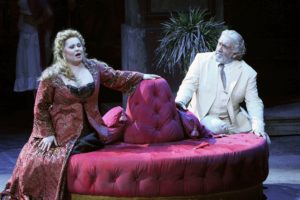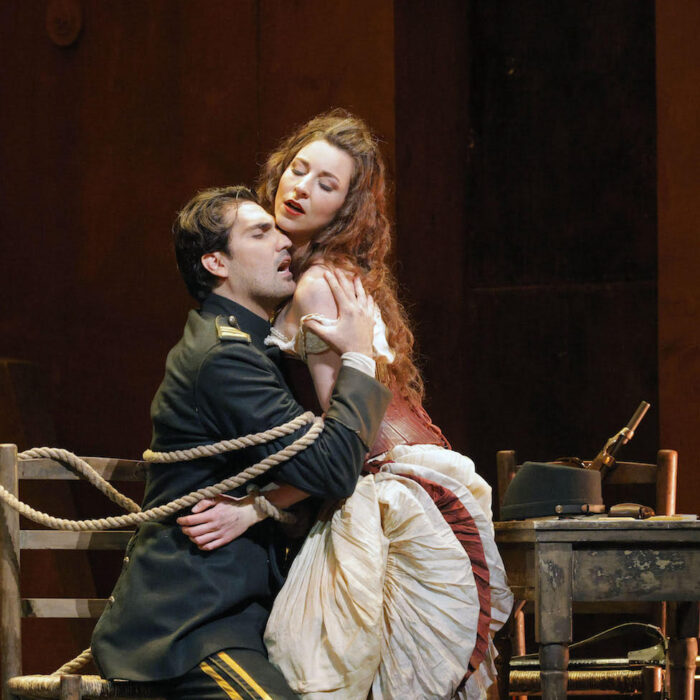
Gran Teatre del Liceu 2017-18 Review – Manon Lescaut
Liudmyla Monastyrska, in Magnificent Voice, Dominates The Evening
By Jonathan SutherlandAny time an opera production begins with non-textual lines, especially in a language different to the libretto, alarm bells ring louder the tubular Grail chimes in “Parsifal.” Such was the case in Davide Livermore’s new staging of “Manon Lescaut” for the Gran Teatre del Liceu which had already been seen in co-production with the Teatro San Carlo in Naples. Instead of opening in a pre-revolutionary square in Amiens c.1760 as Puccini intended, the setting was Ellis Island in New York c.1920’s with “La Liberté éclairant le monde” featuring prominently in the background.
The addition of a non-singing character in the form of Des Grieux in his dotage was no small dramatic liberty, especially as he was skulking around for most of the action and even physically intervened in Act two to hasten his younger self away before the militia appeared. The coincidence that the well-known Catalan actor Albert Muntanyola bore a striking resemblance to such a celebrated Des Grieux as Plácido Domingo was probably not such a bad thing, but his constant presence on stage, frequently holding a crassly sentimental picture of Manon, was at best curious but more often intensely distracting.
Strange American Dream
Livermore’s stage settings assisted by Giò Forma were visually sumptuous but marred by several oddities. The coach from Arras was a Thomas the Tank Engine steam locomotive, but without carriages. It certainly looked impressive with lots of billowing smoke but also made no sense of Geronte’s “Una carrozza e cavalli che volino siccome il vento” when Des Grieux and Manon highjack the engine later, obviously minus driver. Perhaps the infatuated student was learning locomotive engineering. Similar to Robert Carsen’s production for the Wiener Staatsoper, in place of “an extremely elegant salon in Geronte’s house,” Chez Ravoir was a bawdy Edwardian bordello without a soupçon of tasteful hôtel particuliere decor appropriate to the King’s Treasurer-General. Inexplicably di Ravoir was moonlighting as a brothel owner as well as Royal tax collector. There was an upper gallery running the length of the salon with a wide curved staircase more suitable to glitzy entrances at the Folies Bergère. Geronte preferred sex with multiple female partners and Manon was more like prima puttana in a Byzantine harem.
Apart from wall-to-wall whores with lesbian leanings, the Royal Treasurer’s cohorts were far from the crème de la crème of Fauburg St. Honoré society. An epicene hairdresser who bore an uncanny resemblance to Conchita Wurst led the ragbag collection of champagne-swilling hangers-on who may have added color but certainly not class. Lescaut tells Gironte “io completerò, signore, la famiglia” but there was already a tribe of reprobate Roma and indolent riffraff installed under Geronte’s ritzy roof.
The most successful scene was the embarkation port of Le Havre where Nicolas Bovey’s lighting was particularly effective and the undulating seascape projections by someone with the curious culinary appellation of “D-WOK” smacked of salt air and were entirely convincing. Less convincing was the speed with which the vessel departed, making it impossible for Des Grieux and Manon to have boarded. There was also a major nautical inconsistency in that the ship which sped off into the rear scrim was not an 18th century transatlantic clipper but looked like a replica of the SS “Normandie” which wasn’t commissioned until 1935.
The most bizarre scene variation however was in Act Four which instead of “a vast plain on the outskirts of the New Orleans” as Illica and Giacosa specified, was a medical ward back on Ellis Island. Manon was far from “sola, perduta, abbandonata” as there must have been at least 12 other patients in various stages of ill-health on beds immediately next to her. There was also obviously no problem with Des Grieux finding water in a hospital surrounded by lapping waves. Similarly Manon does not need to ask “Chieggo breve riposo – un solo istante,” she is already prostrate. The most effective coup-de-théâtre was during the closing bars when the old Des Grieux pinned a black and white photo of Manon on the forward curtain. It was immediately followed by the projection of dozens of similar mugshots of other hopeful immigrants who had presumably stumbled on the American boulevard of broken dreams.
More Prudence Than Passion
The musical component was similarly variable. This is a score full of ravishing melodies and lyrical climaxes yet Emmanuel Villaume led the orchestra of the Gran Teatro del Liceo with more prudence than passion. The luxuriant first articulation of the “Donna non vidi mai” motif before “Cortese damigella” needed a broader romantic sweep but the short instrumental passage before “Vedete? Io son fedele alla parola mia” had more sensuality. First trumpet gave a peppy fanfare announcing the coach/train from Arras. Woodwinds were especially chirpy and staccato cheeky in the opening to Act two and strings in the Minuetto had lilting lightness. The cello and solo violin introduction to the lento espressivo Intermezzo was mournfully mellifluous and higher strings’ recapitulation of the “nell’occhio tuo profondo” theme poignant and powerful. The interlude ended with some roof raising fortissimi but there was still a sense of restraint in Villaume’s overall reading.
The Liceu chorus of students, peasants, abbés, courtesans, archers, sailors et. al. were certainly not lacking in verve and commitment but there were several occasions on which the choristers were out of synch with the orchestra, especially in the cross rhythm sections of the Minuetto. Livermoore used frequent snap-frozen tableau vivants in many of the crowd scenes but the conceit tended to lose effectiveness due to overuse.
Inconsistencies Abound
There was a noticeable inconsistency in the smaller parts, which is unsurprising given the number of comprimario roles in Puccini’s third opera. In his brief appearance as the compassionate ship’s captain, David Sánchez displayed a strong bass with a really resonant low B natural at “sia pur.” The Innkeeper and Dance Master (Marc Pujol and José Manuel Zapata respectively) were not particularly distinguished but Carol Garcia’s Singer had good moments in the Madrigale with elegant ornamentations and plumy chest notes. Mikeldi Atxakandabaso was not especially impressive as Des Grieux’s abduction facilitator Edmondo and failed to produce the optimal lyricism during “Giovinezza è il nostro nome.” The passage is marked “leziosamente” and “con eleganza” but had neither affectation nor elegance. Atxakandabaso was generally pushed if not labored and the several acciaccature lacked crispness.
Serbian baritone David Bižić sang the contemptible card-sharp parasite-cum-pimp role of Manon’s brother with convincing characterization and some solid mid-register intonation. “In voi un affetto di padre!” was full of knowing wink-wink-nudge-nudge and the following “A chi lo dite” scena with Geronte followed Puccini’s “con finezza” indications admirably. “Una casetta angusta” in Act Two was mellifluously sung with some fine top F sharps.
A Revelation
The revelation of the performance was veteran Spanish baritone Carlos Chausson as the lecherous “incipriato Pluton,” Geronte di Ravoir. This is a singer with a superbly supported old style vocal technique who can project seemingly effortlessly into the remotest corners of the enormous Liceu auditorium. A canon blast “Vostra sorella!” was but one example. Chausson’s precise diction was also an exemplar for younger singers. His insidious insinuation in “È d’uopo consolarla” was masterful. There was devious cad and bounder-ish word coloring in “e via siccome il vento, via, verso Parigi!” and “le prove che v’ho date d’un vero amore” had the resonance and projection of a young Raimondi.
Not Quite On Point
The enamoured ingénue Renato des Grieux was Puccini’s first exceptionally demanding tenor role and Gregory Kunde was neither visually convincing as “Giovinezza è il nostro nome” nor adequately equipped for its wide range of vocal challenges. His first “L’amor, l’amor” sounded strained and covered. “Tra voi, belle, brune e bionde” is marked “con grazia” but had little lightness or grace. The top A fermata on “M’aspetta” was pushed and unpleasant. The showpiece aria “Donna non vidi mai” was not elegant and the top B flat on “Deh! Non cessar” more hooty than “con slancio” as scored. Admittedly Kunde usually has a very solid top and the high B naturals and B flats such as “sul vostro destino,” “fuggiam,” “v’è l’ebbrezza, l’oblio,” and “la scala dell’infamia” were clarion, but the overall phrasing and true Puccini lyric cantilena were generally absent. Dramatically there was minimal chemistry between the ardent student and bellezza of his carnal desire. The normally incandescent “Nelle tue braccia care” duet could have been two strangers in cyberspace agreeing to be friends on Facebook. The most impassioned tenor writing in the score “Come io piango ed imploro” was better sung but still more routine than raw and really rousing.
Superstar Shines
Giusi Giustino’s cutesy blue bow in the hair and matronly costuming made Liudmyla Monastyrska look rather Muppet-esque in Act one, but the soprano ticked all the vocal boxes. The opening “Manon Lescaut mi chiamo” had precisely the right semplicità e modestemente, which Puccini specified and “Il mio fato si chiama, voler del padre mio” was genuinely touching. Monastyrska’s Italian diction would not have won any laurels from Dante Alighieri and her consonants in particular needed much clearer articulation, but musically things were much more secure. “In quelle trine morbide” was taken at a languorous tempo despite being marked moderato con moto, but the Ukrainian soprano managed to shape the extended phrases within Villaume’s ponderous largo pace. That said, it was a convincingly heartfelt interpretation with some fine legato singing at the key change on “O mia dimora umile.” The top B flat on “gaia, isolate” was rock solid and the extended fermata D flat on the final “d’amor” perfectly pitched. The Minueto scena showed sensitive rubato, delicate fioratura, and precise trilling and the emotional outpouring in “non m’ami più!” at Des Grieux’s reappearance evinced genuine suffering. The top C fermata on “amor” at the end of the concertante section in Act Two seemed to go on forever and sent the voice-crazy Catalans wild. Monastyrska’s top B flat ending “il bacio è Dio!” was much more secure than the tenor’s and there was a decent attempt to take “Dolcissimo soffrir!” ppp, which again Kunde avoided. Manon’s abject contempt when she mocks her aged benefactor with “Guardatevi” showed Monastyrska was a fine actress in her own right. Despite lying on a hospital floor instead of crawling around in the unlikely New Orleans desert, “Sola, perduta, abbandonata” had real anguish with a killer B flat on “non voglio morir.”
For all its visual qualities and quirks, this production of “Manon Lescaut” had much to commend it, primarily the intelligent interpretation and vocal assurance of Liudmyla Monastyrska and the extraordinary presence of Carlos Chausson, who not only ran the girls but almost stole the show as well.


